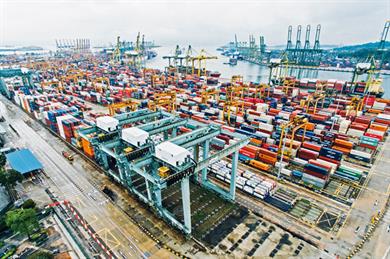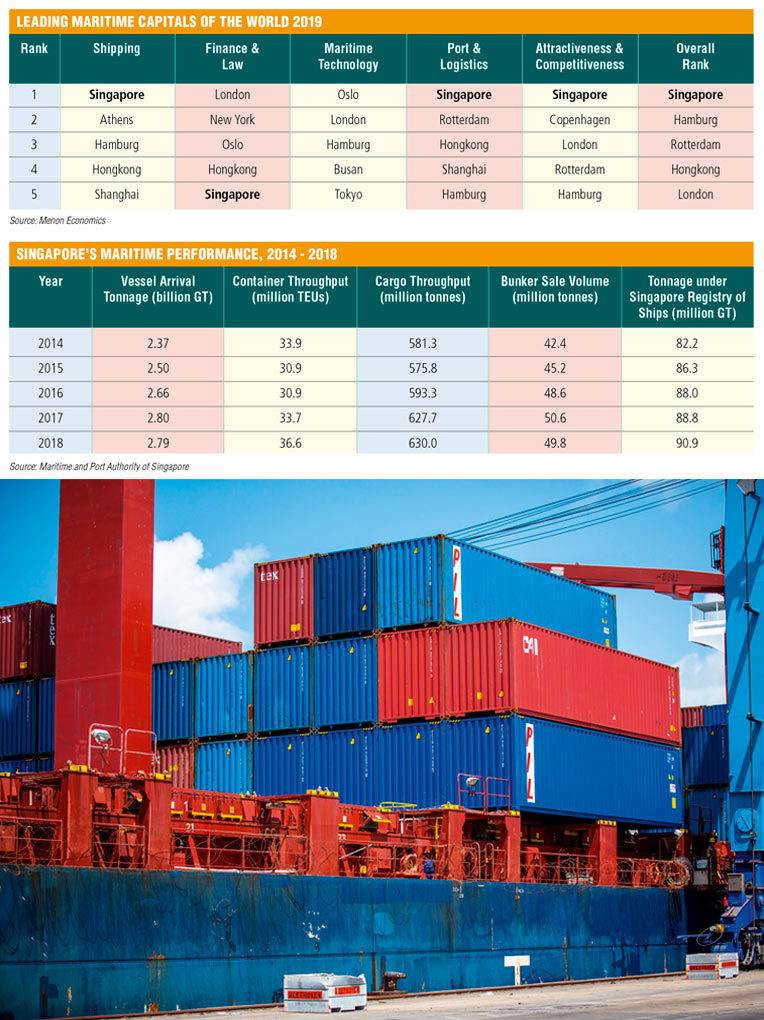 S
Strategically located at the crossroads of east-west trade, Singapore is inextricably linked with shipping and trade. As far back as the 14th century, it was already a regional entrepot, serving as a gateway to the region around south Johor and the Riau Archipelago. But its fortunes were to ebb and flow over the next few centuries.
Sir Stamford Raffles brought about a sea change when he established a trading post in Singapore for the British East India Company in February 1819. By making it a free port, with custom duties imposed only on selected products such as tobacco, opium, alcohol and petroleum, he helped to alter the course of Singapore’s future.
With its natural deep waters, making it easily accessible to ships and junks from around the region and afar, and its comparative orderliness, Singapore became a focal centre for trade in the region. By the 1830s, it overtook Batavia (now Jakarta) as the centre of the Chinese junk trade and supplanted Tanjung Pinang as the export gateway for gambier and pepper for the Riau–Lingga Archipelago.
The opening of the Suez Canal halfway across the world in 1869 reinforced the importance of the Straits of Malacca and Singapore. By slashing the journey between east and west by over 8,200 kilometres, reducing the journey from Europe to Southeast Asia by about a third, the canal contributed to a spike in international trade.
Successive generations of Singapore leaders have built on this. Through strategic vision and leadership, they have leveraged on Singapore’s plum position to build this island nation into a maritime port of distinction. Today, Singapore is a veritable hub for the maritime industry. Within this vibrant eco-system are over 500 companies in port, ship and offshore-related businesses, generating over 170,000 jobs and contributing some 7% to Singapore’s gross domestic product. Over 130,000 ships drop anchor in Singapore each year to handle cargo, take supplies and bunkers, or dock for repairs, making it one of the busiest ports in the world, and helped to spawn a multitude of maritime services, including shipmanagement, shipowning, maritime law, arbitration, shipbroking and ship financing.
Over the last 200 years Singapore has developed well beyond the dreams of its founding fathers, and shipping and trade are key to this success. At the launch of Singapore Bicentennial on 28 January 2019, Prime Minister Lee Hsien Loong noted, “Raffles made Singapore a free port. The new colony prospered, and the population grew rapidly. Immigrants came from Southeast Asia, China, India and beyond...and thus we became a multicultural and open society. Trade was our lifeblood. It linked us to the archipelago around us, and to the world beyond.”
Maritime Singapore Forges Ahead
Maritime Singapore has continued to forge ahead in tandem with the growth of shipping and trade. At the port there is ongoing expansion to ensure Singapore stays ahead of the game. Development is underway to build a megaport at Tuas. When completed in 2040, it will have a container-handling capacity of 65 million TEUs, almost double what Singapore handled in 2017, making it the single largest container terminal in the world. It will replace existing container facilities in Tanjong Pagar, Pasir Panjang, Keppel and Pulau Brani.
Built in four phases, it will have long linear berths and a depth of 23 metres below sea level at the basins and approach channels, enabling it to handle the largest container vessels afloat. The first phase is on track to be fully operational in 2027. It will have 21 deep-water berths capable of handling about 20 million TEUs annually.
Singapore is also continuing to gain in stature as an International Maritime Centre as more companies have come to appreciate the strategic importance of being located in Asia, the world’s most dynamic region. Among the new entrants are the Thenamaris Group, a global ship management company based in Greece, and the World Shipping Council (WSC), a trade association for container liner shipping. Thenamaris incorporated its commercial ship management office in Singapore in March 2018, its first in Asia, while the WSC chose Singapore as base for its Asian office.
The Singapore Registry of Ships is amongst the top five worldwide, reflecting Singapore’s reputation as a quality flag of choice for international ship owners and operators. The total tonnage of ships under the Singapore flag reached 90.9 million GT in 2018.
Leveraging on Technology to Sharpen Competitive Edge
Advancement in technology is disrupting industries upending traditional business models. Digitalisation – the process of converting information from a physical format into a digital one – is changing the way ships are designed and built as well as the way they are operated and managed. Additive manufacturing, also known as 3D printing, allows rapid prototyping of parts for new installations as well as refits reducing costs and production lead-time.
Speaking at the Singapore Maritime Technology Conference in April 2018, Dr Lam Pin Min, Senior Minister of State for Health and Transport, said: “With the rise of digitalisation, the landscape is changing very rapidly. The entry of non-traditional players like Amazon and IBM, and start-ups like VesselBot, is beginning to disrupt the status quo. The industry’s rules of engagement are also changing due to new technologies such as blockchain, artificial intelligence and autonomous technology. Increased digitalisation also brings new cyber risks that can disrupt shipping and its role as a reliable carriage of world trade.”
To ensure Singapore remains relevant, the government is leading the drive to leverage technology to sharpen its competitive edge. At the port, a commercial 3D printing production facility is being built. Jointly developed by the Maritime and Port Authority of Singapore (MPA), National Additive Manufacturing Innovation Cluster (NAMIC), PSA and manufacturing firm 3D Metalforge, it will be the world’s first commercial 3D printing production facility to make spare parts for port equipment. Strategically located at the Pasir Panjang Terminal, where the PSA is testing port technologies for current and future terminals, it will use a specialised maritime digital cloud supported by blockchain technology for more secure file transfers.
This move towards digitised inventories reduces the need to hold excess inventory, which lowers storage costs, while shortening turnaround time from weeks to days due to improved availability of spare parts.
NAMIC, a national programme initiative led by NTUitive, the innovation and enterprise company of Nanyang Technological University, is also collaborating with the Singapore Shipping Association (SSA) on an additive manufacturing (AM) Joint Industry Programme (JIP) for marine parts. The JIP is focused on establishing the commercial viability, technical feasibility and regulatory compliance behind the use of AM for marine parts, to strengthen Singapore’s role as a hub for ship supplies.
The Bill of Lading (BL) is also coming under scrutiny. It is possibly the most important and widely used document in the shipping industry and a prime candidate for change. It contains legal and commercial information providing evidence for the contract of carriage, receipt and ownership of goods for a cargo shipment but paper BLs for a single transaction can run up to hundreds of pages.
Traditionally, the document is mailed to various parties leaving it open to fraud, loss of the original document and document-handling costs resulting in much inefficiency across the supply chain. It is estimated that trade document processing and administration adds 20% to the physical cost of shipping a single container.
A pilot initiative, TradeTrust, will start later this year to switch from paper-based BLs to eBLs. With eBLs, blockchain technology is used to provide all participants with proof of authenticity and provenance for electronic trade documents being exchanged. This would remove the need for repetitive checks by each country to ascertain the legitimacy of documents received.
The Info-communications Media Development Authority (IMDA) will partner the MPA to lead TradeTrust development for eBLs. They will be supported by the Singapore Customs and the SSA.
Speaking in Parliament on 5 March 2019, Minister for Communications and Information S. Iswaran said, “TradeTrust will enhance our attractiveness as a business hub and improve the efficiency of our trading and logistics sectors.”
Related changes to the Electronic Transactions Act will also be made to recognise eBLs to keep pace with international standards. The authorities hope the twin moves will speed up the acceptance of electronic document exchange in the maritime sector across the region, helping to reduce costs for businesses and lower the risk of fraud arising from the current use of paper documents.
Industry leaders have also come on board. Working with Airbus, Singapore-based Wilhelmsen Ships Services is piloting the use of Airbus’ Skyways unmanned air system (UAS) to deliver spares and supplies to vessels at anchorage. The trial, the first time drones are being tested in hectic, real-world port conditions, is a culmination of over a year of planning and collaboration between the two companies, with support from the MPA. Each is capable of carrying up to 4 kilogrammes and reaching vessels as far as 3 kilometres offshore, travelling through dedicated aerial corridors with autonomous control software.
“Delivery of essential spares, medical supplies and cash to master via launch boat is an established part of our portfolio of husbandry services, which we provide day in and day out, in ports all over the world,” says Marius Johansen, Vice President Commercial, Ships Agency at Wilhelmsen Ships Services. “Modern technology such as the unmanned aircraft system, is just a new tool, albeit a very cool one, with which we can push our industry ever forward and improve how we serve our customers.”
By replacing launch boats with drones, delivery costs can be lowered by up to 90%. It is also quicker and safer, with negligible environmental impact.
Wilhelmsen Ships Services is one of four companies tapped by the Civil Aviation Authority of Singapore to help develop the future UAS regulatory framework for Singapore. The selected companies receive dedicated funding for their shore-to-ship delivery projects.
The Next Frontier
More changes are on the cards with the launch of 5G, the fifth-generation wireless standard which has generated immense interests around the world. With its vastly improved Internet speed, coverage and latency, 5G will serve as a springboard for accelerated innovation, reshaping the way we live and work.
Singapore recently allocated S$40 million from its national budget to accelerate the development of 5G applications to support its ambition to lead in the global digital economy. For a start, the IMDA is exploring six strategic clusters where it expects 5G applications to generate the most value for Singapore – maritime operations, urban mobility, smart estates, consumer and government applications and Industry 4.0.
High on the project list is productivity improvement at the Singapore port. Working with telcos Singtel and M1, PSA International is conducting an 18-month trial at the PSA Living Lab in Pasir Panjang to explore the use of driverless vehicles to move shipping containers round the clock between the quay side and the container yard. This will allow the PSA to load and unload more containers and turn around ships faster. The telcos will also set up trials for the remote control of port equipment such as cranes. The trials will pave the way for building the state-of-the-art port at Tuas.
“We see much potential in 5G augmenting our port operations – supporting remote tele-operation of equipment, complementing crane automation and enhancing Automated Guided Vehicle operations – through IoT (Internet of Things) adoption within the port,” said PSA’s regional CEO for Southeast Asia Ong Kim Pong.
